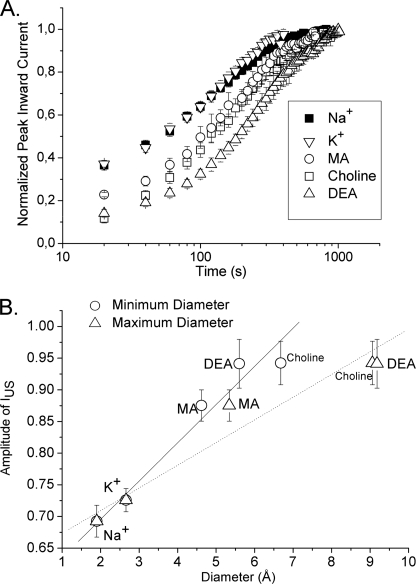FIGURE 8.
Passage of large organic cations through the pore increases the likelihood of entry into IUS. Presumably, the passage of large organic cations through the selectivity filter is associated with an increase in diameter of the pore. If IUS results from a widening of the pore, then the permeation of large cations should increase the likelihood of entry into IUS. A, recovery from the IUS state was assessed in K1237E. The voltage clamp protocol and data analysis were the same as shown in Figs. 1 and 3. The following charge carriers were assessed (90 mm, n = 3–6): Na+, K+, choline, methylammonium (MA), and diethylammonium (DEA). When Na+ was the permeating ion, IUS recovered with a time constant of 155 ± 12 s. This time constant increased during permeation with K+ (175 ± 19 s), MA (208 ± 25 s), choline (208 ± 58 s), and DEA (351 ± 51 s). The amplitudes of IUS were only slightly increased during permeation with K+. Permeation with large organic cations resulted in a substantial increase in the amplitude of IUS (p < 0.05, see panel B for data). B, correlation between the size of permeating ions and the increase in amplitude of IUS is shown. As the parameter of molecular size, we used the diameter calculated from the Pauling ionic radii for Na+ and K+. For the organic cations we calculated the minimum and maximum diameter by using the functions Minimum projection radius and maximum projection radius of the software marvinSketch. Both minimum and maximum diameter were significantly correlated with the amplitude of IUS (p < 0.01).

